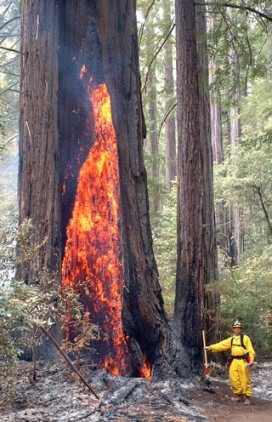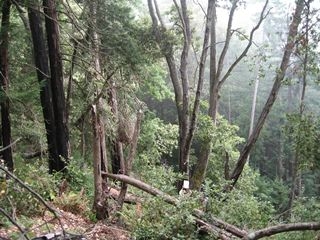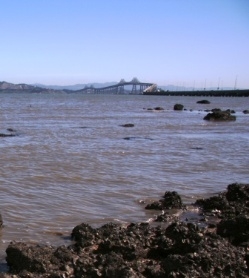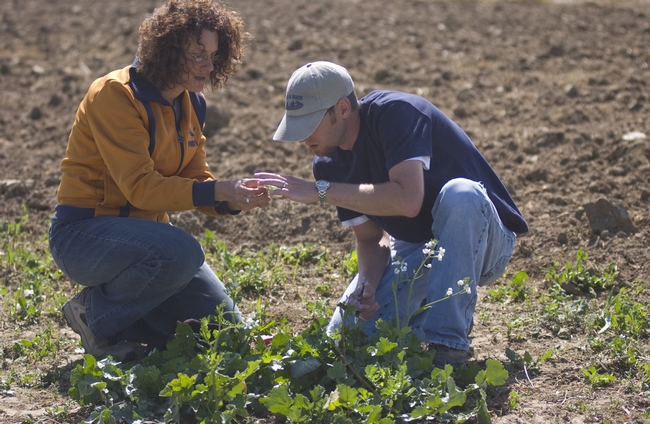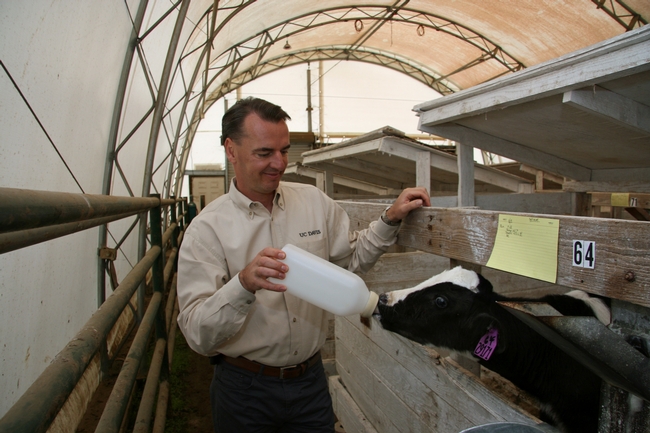Posts Tagged: global warming
Coast redwoods increasingly susceptible to fire damage
California’s renowned coast redwood trees, previously believed to be fireproof, are now more than four times more susceptible to wildfire injury in coastal forest areas infested with the sudden oak death pathogen. These redwoods are now as susceptible to wildfires as other trees.
Millions of trees, including tanoaks, coast live oak, California bay laurels, and many other forest species have been killed by sudden oak death in coastal areas of central and northern California, and Oregon. The pathogen, Phytophthora ramorum, was first linked to the massive tree death in the mid-1990s.
David Rizzo, professor in the Department of Plant Pathology at UC Davis, and his research team are studying how the coastal forest ecology is changing since sudden oak death appeared, and why coast redwoods (Sequoia sempervirens) are subsequently so much more susceptible to fire.
It is the presence of the sudden oak death pathogen in forests that poses heavier fire risks for redwoods.
“If redwoods didn’t live in forests affected by the disease, they could withstand fires just fine,” says Margaret Metz, a postdoctoral research scholar working with Rizzo.
An initial explanation for the higher redwood mortality following wildfires is heavier fuel loads (such as fallen, dead branches from tanoaks) in forests affected by sudden oak death. Tanoak, Notholithocarpus densiflorus, is the primary host dying from sudden oak death and the main source of pathogen inoculum.
According to Rizzo, “The disease likely created more fuel for wildfires as dead tanoak branches fell. The loss of the oaks also would have decreased the amount of shade, drying out the forest and turning it into a tinder box, one not even redwoods could survive.”
A real key, though, is the finding that dead tanoaks, still standing, carry flames high into tree canopies, scorching the crowns of adjacent redwood trees. It’s this crown injury that is believed to have caused so many redwood trees to die in a number of fires that occurred in 2008.
Rizzo, noting that an increase in fire severity is resulting from climate change and global movement of species, says, “There may be all sorts of consequences, among them, dead and dying coast redwoods.”
Additional information:
- California's iconic redwoods in danger from fire and infectious disease. National Science Foundation report on Rizzo group’s work, August 2013
- The effects of sudden oak death and wildfire on forest composition and dynamics in the Big Sur ecoregion of coastal California. General technical report
- Ecology research article, Ecological Society of America
- California Oak Mortality Task Force website
Bodega Marine Lab keeps watch on ocean temperatures
Ocean waters are warming, sea level is rising, seawater is becoming more acidic, and shoreline erosion is intensifying. The world’s oceans are reacting to increased carbon dioxide and other greenhouse gases in the earth’s atmosphere.
“The physical and chemical environment of the ocean is changing with the climate,” said John Largier of the UC Davis Bodega Marine Laboratory. “This affects ecosystems — like tidal marshes and coral reefs that protect us from storms and flooding.”
The ocean brings stability to the earth’s climate. It heats up and cools down more slowly than the land and the air. With climate change, the ocean absorbs excess heat trapped in the earth’s system by the increased concentration of gases in the atmosphere.
As seawater warms, it expands. The increase in the ocean’s heat content has contributed to one of the most visible effects of global warming — rising sea level. Thermal expansion, along with melting polar ice caps and glaciers, has led to global sea level rise of more than seven inches over the last century.
“When the ocean begins to warm up, then you know that the earth’s climate is changing,” said Largier, a professor in the Department of Environmental Science and Policy. “Even if we stop putting greenhouse gases into the atmosphere right now, the ocean has warmed up, and it will take centuries for it to cool down. People don’t realize that we’ve already made a long-term commitment to climate change.”
At the Bodega Marine Lab, Largier and other scientists are studying the regional impacts of climate change on the waters off California, which include an increase in coastal upwelling. Driven by winds, upwelling pulls cold water and nutrients from the ocean depths to the surface along the shore and contributes to the “marine layer,” the blanket of cool moist air that moderates California temperatures. Largier’s research shows a trend toward stronger winds and an increase in upwelling since 1982, leading to cooler waters off central and northern California.
“Worldwide, the ocean’s surface water is getting warmer, but in California, the ocean is getting colder near shore,” said Largier. “This is intriguing because it shows that climate change is not going to have the same effect everywhere. There will be regional differences.”
This article was condensed slightly from UC Davis “CA&ES Outlook” magazine. Read the full article on page 7.
Read John Largier's scientific advisory group report on how changes in the ocean might affect two valuable marine sanctuaries off the northern California coast: "Climate Change Impacts: Gulf of the Farallones and Cordell Bank National Marine Sanctuaries"
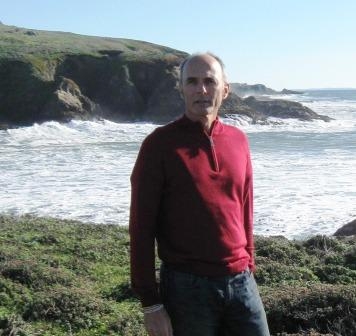
John Largier along the northern California coast. (Photo: Jennifer Sauter/UC Davis)
Weather changes, global warming doesn’t
The first thing I had to learn as writing staff at the John Muir Institute for the Environment, UC Davis, was the difference between "climate" and "weather." I compare it to reading a stock chart, there are jagged peaks and valleys daily, but it takes stock performance over years to reveal an unmistakable trend. The small ticks are similar to weather but the trend over decades is closer to climate. Nearly every stock chart has a huge valley at the year 2008, this is thought to be a once in a century event. That event is analogous to climate change, except climate trends are measured over millions of years, and climate is thought to be much slower to recover.
American opinions about global warming are as uncertain as the stock market and as changeable as the weather, according to The Center for Climate Communications at George Mason University in Fairfax, Virginia. The center just released the results of their second survey entitled, "Climate Change in the American Mind: Americans' Global Warming Beliefs and Attitudes in April 2013."
Highlights include:
- Nearly two in three Americans (63%) believe global warming is happening. Relatively few - only 16 percent - believe it is not.
- Of the 63% who believe global warming is happening most say they are "very" (33%) or "extremely sure" (27%). By contrast, of the unconvinced, fewer are very (28%) or extremely sure of their view (18%).
- About half of Americans (49%) believe global warming - if it is happening - is caused mostly by human activities, a decrease of 5 points since fall 2012, but similar to levels stretching back several years.
- More Americans believe that "most scientists think global warming is happening" (42%) than believe there is widespread disagreement among scientists (33%).
- At least four out of ten Americans say global warming will harm people in their community (45%), their family (44%), or themselves (42%).
I had the privilege to acquire my understanding of climate by listening to the top researchers in the field, and writing about their discoveries. Without that opportunity, I might easily have been a skeptic since that is closer to my nature.
Climate science is seriously underrated by the public and even by scientists outside the field. Climate studies are complex, requiring knowledge from multiple disciplines ranging from geology, to physical chemistry and ecology. Forget Doppler radar and weather balloons. When an acquaintance stated unequivocally that climate science is not "real science," it was his lack of appreciation for climate science that was talking as well as his nature. His Ph.D. in chemistry, earned decades ago, had not yet revealed the role of chemistry in predicting climate. Historical evidence has been collected from stalactites, ocean sediments and ice cores, some of which were formed while Neanderthals and Homo sapiens were competing for caves.
What we learned about the carbon cycle in high school earth science has been long forgotten. Ask the average scientist to expound on the carbon cycle, their eyes glaze over on the connections between oceans, the atmosphere and the soils. They are focused on more immediate threats, such as the complex relationship between inflammation and the formation of plaque in their arteries.
Now that the atmosphere is estimated to contain 400 parts per million of carbon dioxide, perhaps the next species of man, Homo climatcans, will learn to act on the science that the majority of us have yet to discover.
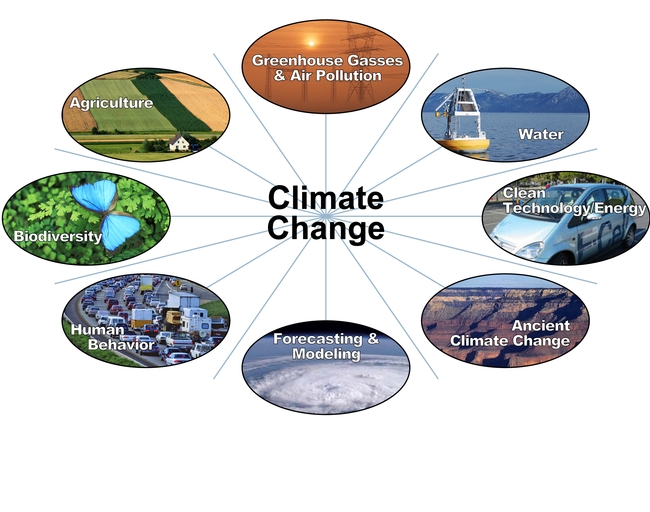
ClimateChange
Feeding billions in the face of climate change
As drought dries the landscape and rising global temperatures make for decreasing crop yields, farmers are faced with the question of how to feed billions of people in a way that both reduces global greenhouse gas emissions and adapts to the realities of climate change.
Scientists and policymakers from around the world will gather today through Friday, March 20-22, at the University of California, Davis, to grapple with the threats of climate change for global agriculture and recommend science-based actions to slow its effects while meeting the world's need for food, livelihood and sustainability.
The Climate-Smart Agriculture Global Science Conference, planned in coordination with the World Bank, builds on a 2011 international meeting on this theme in the Netherlands.
"Climate change, which brings severe weather events and more subtle but equally menacing temperature changes, presents unprecedented challenges to the global community," said UC Davis Chancellor Linda P.B. Katehi.
"In California, where we rely heavily on snowmelt for irrigation to grow half of our nation's fruit and vegetables, we are acutely aware that scientists and policymakers must join forces to lessen the potential effects of climate change," she said.
Katehi will open the conference on Wednesday, March 20, along with Thomas Vilsack, secretary of the U.S. Department of Agriculture (via video). The public is invited to attend the opening day’s program (8:45 a.m.-12:30 p.m), free of charge; and the closing day’s afternoon program (noon-3:45 p.m.), also free of charge. These will be held in Jackson Hall of the Mondavi Center for the Performing Arts. (Lunches not included.)
Catherine Woteki, USDA undersecretary, will speak Thursday evening, March 21.
Other speakers will include: Ben Santer, climate researcher at Lawrence Livermore National Laboratory and a member of the National Academy of Sciences; Joseph Alcamo, chief scientist for the United Nations Environmental Program; and Patrick Caron, general director for research and strategy of the French Agricultural Research Center for International Development. Also speaking will be outstanding scientists from dozens of universities and research institutes from around the world.
Conference topics will focus on the implications of cutting-edge agricultural, ecological and environmental research for improved design of policies and actions affecting agricultural management and development; identifying farm and food-system issues, determining research gaps; highlighting emerging research initiatives; and developing transformative policies and institutions.
The conference will conclude with participants developing and endorsing a declaration regarding the key research and policy messages that result from conference presentations and discussions. This declaration is expected to point toward science-based policies and actions for global agriculture that will mitigate climate change and encourage adaptation to maintain food security, livelihoods and biodiversity.
UC Davis scientist to lead UN effort to study livestock’s environmental impact
In the aftermath of Hurricane Sandy, climate change and global greenhouse emissions are a hot topic these days. Dozens of UC Davis scientists study many facets of the causes and consequences of global warming.
One of them is Frank Mitloehner, UC Cooperative Extension specialist and professor in the Department of Animal Science at UC Davis. Mitloehner has studied the role of the livestock industry in contributing to greenhouse gas emissions. Mitloehner was recently selected to chair a United Nations committee to measure and assess the environmental impacts of the livestock industry.
As chair of the new Food and Agriculture Organization of the United Nations (FAO) committee, he will lead representatives of national governments, livestock industries, nonprofits, and the private sector in establishing science-based methods to quantify livestock’s carbon footprint, create a database of greenhouse gas emission factors for animal feed, and develop a methodology to measure other environmental pressures, such as water consumption and nutrient loss.
“By the end of three years, we’ll have a methodology that’s globally accepted, that anyone in the world can use to quantify the environmental impact of their livestock,” Mitloehner said.
The FAO estimates that meat consumption will increase 73 percent by 2050 and dairy consumption will grow 58 percent over current levels. Methods of raising livestock differ throughout the world, with American producers being among the world’s most efficient. For instance, it takes approximately 20 Indian cows to produce as much milk as one dairy cow in the United States.
Mitloehner’ s research has found that livestock account for 3.4 percent of greenhouse gas emissions in the United States. The transportation sector, on the other hand, contributes roughly 26 percent.
“Transportation choices continue to be the main contribution to climate change and not, as is often depicted, food choices,” Mitloehner says. “This new program is an effort to harmonize methodologies to benchmark the environmental impact of livestock.”
Among the founding members of the committee are the governments of France, Ireland, the Netherlands, and New Zealand, as well as the European Feed Manufacturers’ Federation, the European Vegetable Oils and Proteinmeal Industry, the International Dairy Federation, the International Meat Secretariat, the International Egg Commission, the International Poultry Council, the International Federation for Animal Health, and the World Wildlife Fund.


